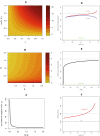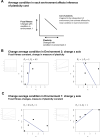Condition dependence and the paradox of missing plasticity costs
- PMID: 37033877
- PMCID: PMC10078974
- DOI: 10.1093/evlett/qrad009
Condition dependence and the paradox of missing plasticity costs
Abstract
Phenotypic plasticity plays a key role in adaptation to changing environments. However, plasticity is neither perfect nor ubiquitous, implying that fitness costs may limit the evolution of phenotypic plasticity in nature. The measurement of such costs of plasticity has proved elusive; decades of experiments show that fitness costs of plasticity are often weak or nonexistent. Here, we show that this paradox could potentially be explained by condition dependence. We develop two models differing in their assumptions about how condition dependence arises; both models show that variation in condition can readily mask costs of plasticity even when such costs are substantial. This can be shown simply in a model where plasticity itself evolves condition dependence, which would be expected if costly. Yet similar effects emerge from an alternative model where trait expression itself is condition-dependent. In this more complex model, the average condition in each environment and genetic covariance in condition across environments both determine when costs of plasticity can be revealed. Analogous to the paradox of missing trade-offs between life history traits, our models show that variation in condition can mask costs of plasticity even when costs exist, and suggest this conclusion may be robust to the details of how condition affects trait expression. Our models suggest that condition dependence can also account for the often-observed pattern of elevated plasticity costs inferred in stressful environments, the maintenance of genetic variance in plasticity, and provides insight into experimental and biological scenarios ideal for revealing a cost of phenotypic plasticity.
Keywords: GxE; condition dependence; life history trade-off; phenotypic plasticity.
© The Author(s) 2023. Published by Oxford University Press on behalf of The Society for the Study of Evolution (SSE) and European Society for Evolutionary Biology (ESEN).
Figures




Similar articles
-
Constraints on the evolution of phenotypic plasticity: limits and costs of phenotype and plasticity.Heredity (Edinb). 2015 Oct;115(4):293-301. doi: 10.1038/hdy.2015.8. Epub 2015 Feb 18. Heredity (Edinb). 2015. PMID: 25690179 Free PMC article. Review.
-
The emergence of performance trade-offs during local adaptation: insights from experimental evolution.Mol Ecol. 2017 Apr;26(7):1720-1733. doi: 10.1111/mec.13979. Epub 2017 Jan 13. Mol Ecol. 2017. PMID: 28029196 Review.
-
Characterization, costs, cues and future perspectives of phenotypic plasticity.Ann Bot. 2022 Sep 6;130(2):131-148. doi: 10.1093/aob/mcac087. Ann Bot. 2022. PMID: 35771883 Free PMC article. Review.
-
GENETIC VARIATION FOR PHENOTYPIC PLASTICITY IN THE LARVAL LIFE HISTORY OF SPADEFOOT TOADS (SCAPHIOPUS COUCHII).Evolution. 1994 Dec;48(6):1773-1785. doi: 10.1111/j.1558-5646.1994.tb02213.x. Evolution. 1994. PMID: 28565166
-
Phenotypic plasticity is not affected by experimental evolution in constant, predictable or unpredictable fluctuating thermal environments.J Evol Biol. 2015 Nov;28(11):2078-87. doi: 10.1111/jeb.12735. Epub 2015 Sep 6. J Evol Biol. 2015. PMID: 26299271
Cited by
-
Sexual conflict, heterochrony and tissue specificity as evolutionary problems of adaptive plasticity in development.Proc Biol Sci. 2023 Oct 11;290(2008):20231854. doi: 10.1098/rspb.2023.1854. Epub 2023 Oct 11. Proc Biol Sci. 2023. PMID: 37817601 Free PMC article. Review.
References
-
- Anichini, M., Rebrina, F., Reinhold, K., & Lehmann, G. U. C. (2019). Adaptive plasticity of bushcricket acoustic signalling in socially heterogeneous choruses. Animal Behaviour, 158, 139–148.
-
- Bohrnstedt, G. W., & Goldberger, A. S. (1969). On the exact covariance of products of random variables. Journal of the American Statistical Association, 64, 1439–1442.

